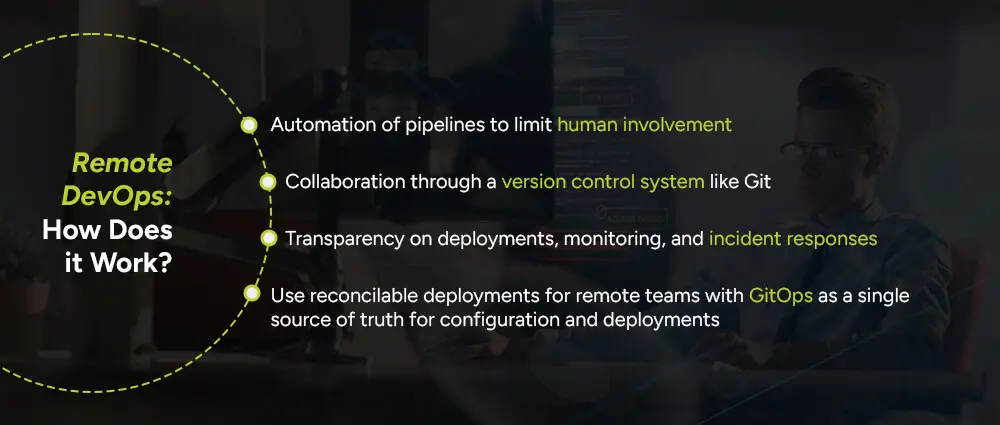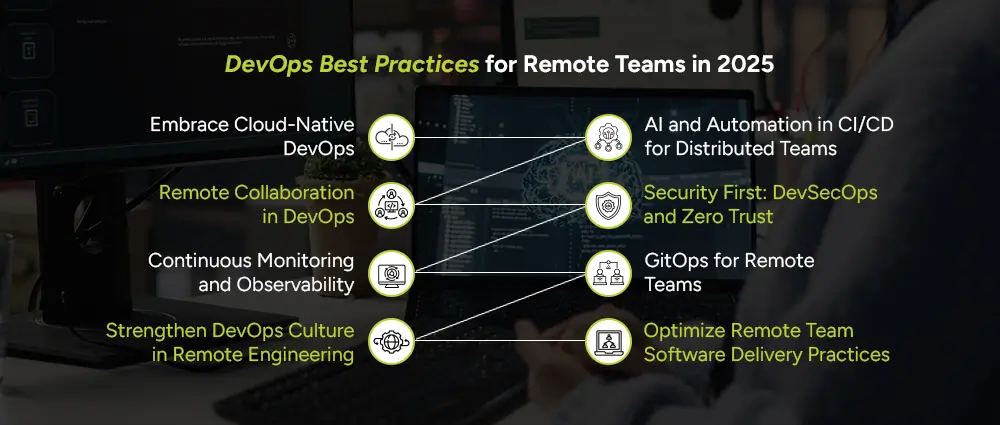The way we build, deliver, and maintain software has changed drastically in the last few years. As companies increasingly embrace remote and hybrid work models, remote collaboration in DevOps has become the backbone of distributed engineering teams. By 2025, new advancements, ranging from AI-powered automation to zero-trust security, are reshaping the way DevOps for hybrid and remote teams operates.
Today, we are diving deep into the tools and best practices for remote DevOps, exploring how organizations can maintain collaboration, culture, and efficiency while managing distributed teams.
Talking about how remote engineering teams now have DevOps practices, we need to go back and at least learn a bit about DevOps first.
So, What is DevOps?
DevOps is more than a set of business intelligence tools for Startups; it’s a cultural and technical approach that combines software development (Dev) and IT operations (Ops) to deliver software faster, with higher quality and greater reliability.
DevOps culture accentuates collaboration, automation, continuous integration (CI), continuous delivery (CD), and shared ownership. In 2025, cloud-native DevOps transformed this culture, allowing distributed teams to manage infrastructure, deploy updates, and live up to customer expectations.
The fundamental areas of remote software delivery methods for teams are:

The pandemic fast-tracked the transition to DevOps management from anywhere, which has now become all too common in 2025 for various engineering teams. Remote DevOps integrates cloud-native platforms, CI/CD for distributed teams, and collaboration tools that facilitate asynchronous work.
While managing DevOps teams remotely offers flexibility, global reach, and access to diverse talent, it also comes with a unique set of challenges that organizations need to address carefully:
When people come from different parts of the world or time zones, it becomes a challenge for them to be on the same page. Misunderstandings or delays in sharing information further could pose issues within the development cycle, missed deadlines, and even critical errors. Clear and consistent communication gets more important than ever before.
The very nature of remote working environments tends to increase the number of points of entry for possible cyber threats. Employees are likely to connect to the organization from some unsecured network or personal devices, and such use exposes the system to breaches. That calls for a ‘zero-trust’ security model, where no device or user comes trusted by default, so that data and systems are kept secure.
Remote teams often use a variety of tools for development, communication, testing, and deployment. When these tools fail to connect or share information effectively, it creates silos, isolated systems that don’t communicate with each other. This can slow down workflows and lead to confusion or duplication of work.
The fast response to system failure or outages is an important part of DevOps. However, it’s hard to schedule on-call time for groups across time zones and respond quickly. Fast and smooth remote incident response coordination therefore requires clear protocols and, whenever possible, automation.
Building and sustaining an effective DevOps culture in a remote team is among the most unappreciated challenges. Daily face-to-face interaction keeps the fire of spirit, values, and collaboration going. Leaders need to be intentional in creating bonded people who recognize each other and have some common goals.

To tackle these challenges, companies must adopt modern DevOps strategies and collaboration tools that keep distributed teams aligned and productive,. These are known as DevOps best practices, which are:
In 2025, cloud-native DevOps will rely on containerization, microservices, and serverless architectures. Kubernetes, AWS EKS, and Azure AKS help teams deploy applications globally, which ensures low latency and high availability for end users.
Significance:
Automation is the foundation of in-house or outsourced DevOps as a service. In 2025, AI has supercharged CI/CD pipelines, enabling predictive analysis, faster deployments, and self-healing systems.
Best practices:
To have remote collaboration on DevOps, a proper way must be employed to communicate as well as track projects. Nowadays, Slack or Microsoft Teams, and Zoom are directly being integrated into CI/CD pipelines or ChatOps for real-time updates.
Best Practices:
Security should not be an afterthought, particularly when considering remote teams. The adoption of DevSecOps services assures that security gets consideration in the early stages of the software development life cycle.
Best practices include:
Being remote means that visibility is important for DevOps. Continuous monitoring and observability tools like Datadog, Prometheus, and Grafana enable teams to track performance and identify issues before they arise.
Best practices include:
GitOps have become the highest standard for the management of infrastructures and deployments. Using Git repositories as the single source of truth affords the remote team to confidently deploy changes.
Best practices:
Cultural alignment is very important for success in the remote setting. In enhancing the DevOps culture in remote engineering, the best practices that we should adapt are:
For remote team software delivery practices, focus on small, frequent releases rather than large, risky deployments.
To ensure that managing DevOps remotely is seamless, teams must adopt the right toolchain.
Must-have categories:
To evaluate how effective the teams have been, the following metrics should be monitored:
The future of remote collaboration in DevOps is being shaped by AI, automation, and decentralized technologies. Expect to see:
Managing DevOps remotely, from this point on, is a permanent phenomenon. Companies are thriving in a distributed work environment by implementing DevOps best practices for remote teams; relying on key trends of remote DevOps as a service collaboration tools; and building a culture of transparency and automation.
Remote teams’ software building and delivery activities are being transformed by cloud-native DevOps 2025, AI-enabled CI/CD pipelines, and GitOps. If organizations truly make investments in remote software delivery practices and the right toolchain, they will not just keep pace with these advancements, but, instead, will lead the path into the future of digital innovation.
Are you ready to future-proof your engineering teams, then? Implement these immediately with Arpatech for remote DevOps services to deliver software in 2025-Faster, Safer, and Smarter.
DevOps, in its core aspect, is the simultaneous existence of four key principles:
An introduction to the 7 principles of DevOps: